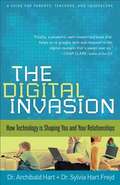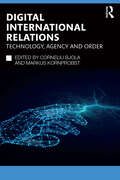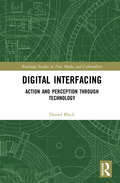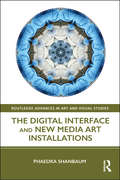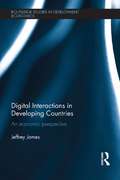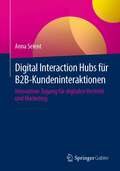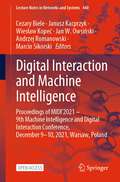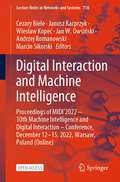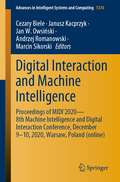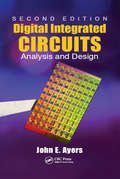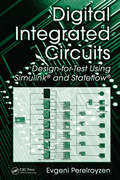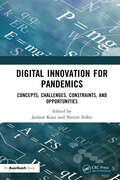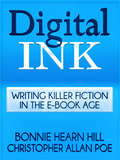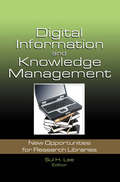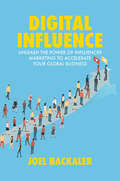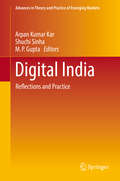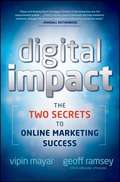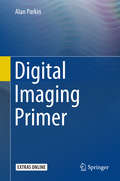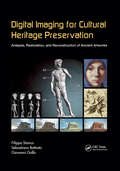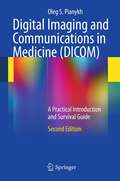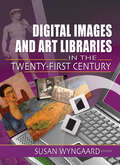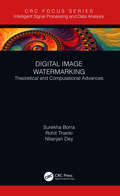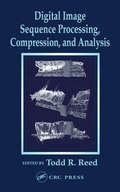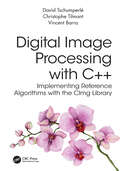- Table View
- List View
The Digital Invasion: How Technology Is Shaping You and Your Relationships
by Archibald D. Hart Sylvia Hart FrejdIn the world of technology, there are just two kinds of people: digital natives and digital immigrants. Digital natives are those born after the advent of the internet. They are comfortable with swift technological change and take the presence of technology in their lives almost completely for granted. They have "digital DNA" flowing through their bodies. On the other hand, digital immigrants are those born before the advent of the internet. Their comfort level with our technology-soaked world is more variable. But they are affected by the digital invasion just as much as their native children. With the latest research supporting them, Dr. Archibald Hart and Dr. Sylvia Hart Frejd uncover both the subtle and the dramatic ways digital technology is changing us from within, focusing their exposé on the impact on the spiritual life of individuals. Through insights from neuroscience and psychology, they offer readers therapeutic and biblical strategies for handling the digital invasion in order to become good stewards of their digital lives. Parents, educators, students, counselors, and pastors will especially appreciate this cultural wake-up call. Much of the focus is from a Christianity perspective, but a lot of good information about what use of technology (especially excessive addictive) does to the brain and our ability to function
Digital International Relations: Technology, Agency and Order (Routledge Studies in Conflict, Security and Technology)
by Corneliu Bjola Markus KornprobstThis book analyses how digital transformation disrupts established patterns of world politics, moving International Relations (IR) increasingly towards Digital International Relations. This volume examines technological, agential and ordering processes that explain this fundamental change. The contributors trace how digital disruption changes the international world we live in, ranging from security to economics, from human rights advocacy to deep fakes, and from diplomacy to international law. The book makes two sets of contributions. First, it shows that the ongoing digital revolution profoundly changes every major dimension of international politics. Second, focusing on the interplay of technology, agency and order, it provides a framework for explaining these changes. The book also provides a map for adjusting the study of international politics to studying International Relations, making a case for upgrading, augmenting and rewiring the discipline. Theory follows practice in International Relations, but if the discipline wants to be able to meaningfully analyse the present and come up with plausible scenarios for the future, it must not lag too far behind major transformations of the world that it studies. This book facilitates that theoretical journey. This book will be of much interest to students of cyber-politics, politics and technology, and International Relations.
Digital Interfacing: Action and Perception through Technology (Routledge Studies in New Media and Cyberculture)
by Daniel BlackThis book takes the interface – or rather to interface, a process rather than a discrete object or location – as a concept emblematic of our contemporary embodied relationship with technological artefacts. The fundamental question addressed by this book is: How can we understand what it means to perceive or act upon the world as a body–artefact assemblage? Black works to clarify the role of artefacts of all kinds in human perception and action, then considers the ways in which new digital technologies can expand and transform this capacity to change our mode of engagement with our environment. Throughout, the discussion is grounded in specific technologies – some already familiar and some still in development (e.g. new virtual reality and brain–machine interface technologies, natural user interfaces, etc.). In order to develop a detailed, generalizable theory of how we interface with technology, Black assembles an analytical toolkit from a number of different disciplines, including media theory, ethology, clinical psychology, cultural theory, philosophy, science and technology studies, cultural history, aesthetics and neuroscience.
The Digital Interface and New Media Art Installations (Routledge Advances in Art and Visual Studies)
by Phaedra ShanbaumThis book is about the digital interface and its use in interactive new media art installations. It examines the aesthetic aspects of the interface through a theoretical exploration of new media artists, who create, and tactically deploy, digital interfaces in their work in order to question the socio-cultural stakes of a technology that shapes and reshapes relationships between humans and non-humans. In this way, it shows how use of the digital interface provides us with a critical framework for understanding our relationship with technology.
Digital Interactions in Developing Countries: An Economic Perspective (Routledge Studies in Development Economics #99)
by Jeffrey JamesJeffrey James is one of the relatively few academics to have systematically taken on the topic of IT and development. In this timely book he undertakes a methodological critique of prominent topics in the debate. Challenging the existing literature by international and governmental institutions, the book looks not only at the digital divide but also at issues such as digital preparedness, leapfrogging and low-cost computers. James also raises important issues which have been largely neglected in the literature, such as the implications for poverty in developing countries and the macroeconomics of mobile phones. The book argues that benefits from IT are captured in a different form in developing as opposed to developed countries. In the latter, gains come from technology ownership and use, whereas in the former, benefits cannot be captured as much in this way because ownership is more limited. Interestingly, the author shows that developing countries have responded to this distinction with a series of local innovations which are often low-cost and pro-poor. This finding contradicts the widely held view that poor countries are unable to generate major innovations within their own borders. Accessible and clearly written, this book will be of great interest to scholars of development economics and development studies, and is relevant to both policy-makers and academics.
Digital Interaction Hubs für B2B-Kundeninteraktionen: Innovativer Zugang für digitalen Vertrieb und Marketing
by Anna SelentDieses Buch befasst sich mit dem B2B-Softwarekauf, den relevanten Buyer Personas, den kaufbezogenen digitalen Interaktionen und deren Knotenpunkten („Hubs“). Die Autorin präsentiert eigene Forschungserkenntnisse aus der Industrie und leitet daraus praxisnahe Konzepte und Inhalte ab.Mehr als zwei Drittel der Interaktionen im B2B-Kaufprozess werden heute digital und vorzugsweise autonom ausgeführt. Der späte Einstieg der Vertriebsbeauftragten in den Kaufprozess schwächt die Einfluss- und Erfolgschancen des persönlichen Vertriebs. Digitale Kundeninteraktionen gewinnen an hoher Bedeutung. Dutzende von Touchpoints und eine Vielfalt an Interaktionsoptionen – wie z. B. Beiträge in sozialen Medien und Fach-Communitys, Testversionen, YouTube-Videos, Webinare, Whitepapers, Kundenstimmen etc. – fließen in die B2B Buyer's Journey ein und überfordern Anbieter bei ihrem Versuch, die potenziellen Käufer online zu erreichen.Anna Selent identifiziert neun Digital Interaction Hubs (DIHs) im B2B-Kauf und -Verkaufsprozess, die einen innovativen Zugang zu den relevantesten Anbieter-Käufer-Interaktionen darstellen und die Komplexität reduzieren. Diese bilden das Grundgerüst für einen käuferadäquaten Online-Auftritt der Webseite des Anbieters und seiner digitalen Vertriebs- und Marketingaktivitäten auf externen Plattformen. Sie zeigt, wie Gestaltungs- und Handlungsempfehlungen dem Anbieter dabei helfen, die DIHs schrittweise auf- und auszubauen und optimal im Vertriebs- und Vermarktungsprozess der B2B-Angebote zur Kundengewinnung einzusetzen. Damit erreichen die Anbieter ihre potenziellen Käufer während des gesamten Kaufzyklus, und zwar unabhängig davon, wann und wie die einzelnen Buyer's Journeys von relevanten Buyer Personas verlaufen. Das Buch ist ein Leitfaden für den Aufbau oder Relaunch der Webseite mit konkreter inhaltlicher Ausgestaltung und vertrieblicher Schwerpunktsetzung. Marketing- und Vertriebsverantwortliche erhalten wertvolle Einsichten und Impulse zu den Themen der digitalen Kundeninteraktionen.„Eine Arbeit, die wirklich relevant ist für das Industriemarketing und die mit den Digital Interaction Hubs einen wesentlichen Schritt im ganzen Dschungel des digitalen Marketings weiterführt“. Prof. em. Dr. Christian Belz, Universität St.Gallen
Digital Interaction and Machine Intelligence: Proceedings of MIDI’2021 – 9th Machine Intelligence and Digital Interaction Conference, December 9-10, 2021, Warsaw, Poland (Lecture Notes in Networks and Systems #440)
by Cezary Biele Janusz Kacprzyk Wiesław Kopeć Jan W. Owsiński Andrzej Romanowski Marcin SikorskiThis book is open access, which means that you have free and unlimited access.This book presents the Proceedings of the 9th Machine Intelligence and Digital Interaction Conference. Significant progress in the development of artificial intelligence (AI) and its wider use in many interactive products are quickly transforming further areas of our life, which results in the emergence of various new social phenomena. Many countries have been making efforts to understand these phenomena and find answers on how to put the development of artificial intelligence on the right track to support the common good of people and societies. These attempts require interdisciplinary actions, covering not only science disciplines involved in the development of artificial intelligence and human-computer interaction but also close cooperation between researchers and practitioners. For this reason, the main goal of the MIDI conference held on 9-10.12.2021 as a virtual event is to integrate two, until recently, independent fields of research in computer science: broadly understood artificial intelligence and human-technology interaction.
Digital Interaction and Machine Intelligence: Proceedings of MIDI’2022 – 10th Machine Intelligence and Digital Interaction – Conference, December 12-15, 2022, Warsaw, Poland (Online) (Lecture Notes in Networks and Systems #710)
by Cezary Biele Janusz Kacprzyk Wiesław Kopeć Jan W. Owsiński Andrzej Romanowski Marcin SikorskiThis open access book presents the proceedings of the 10th Machine Intelligence and Digital Interaction Conference. Artificial intelligence (AI) is rapidly affecting more aspects of our lives as a result of significant advancements in its research and the widespread usage of interactive technologies. This has led to the birth of several new social phenomena. Many nations have been working to comprehend these phenomena and discover solutions for moving artificial intelligence development in the proper direction to benefit individuals and communities at large. These efforts necessitate multidisciplinary approaches, encompassing not only the scientific fields involved in the creation of artificial intelligence and human–computer interaction but also strong collaboration between academics and practitioners. Because of this, the primary objective of the MIDI conference, which was conducted online on December 13–15, 2022, is to combine two up until recently distinct disciplines of research—artificial intelligence and human–technology interaction.
Digital Interaction and Machine Intelligence: Proceedings of MIDI’2020 – 8th Machine Intelligence and Digital Interaction Conference, December 9-10, 2020, Warsaw, Poland (online) (Advances in Intelligent Systems and Computing #1376)
by Cezary Biele Janusz Kacprzyk Jan W. Owsiński Andrzej Romanowski Marcin SikorskiThis book presents the Proceedings of MIDI’2020 – 8th Machine Intelligence and Digital Interaction Conference, December 9–10, 2020, Warsaw, Poland, held online. The rapid development of artificial intelligence (AI) and its growing applications in many fields, such as intelligent voice assistants, e-commerce (chatbots) or navigation, make end users increasingly exposed to such systems. In a world where technological solutions based on artificial intelligence are created by people for people, the final success or failure of a newly created product depends on the focus on human needs. Therefore, it is important to integrate so far independent scientific areas: broadly defined artificial intelligence and human–technology interaction. This book is intended for specialists in the above fields and attempts to integrate the perspectives of engineers and social scientists. The book is a source of inspiration as well as practical and theoretical knowledge for all readers interested in new trends in the field of user-centered AI solutions.
Digital Integrated Circuits: Analysis and Design, Second Edition
by John E. AyersExponential improvement in functionality and performance of digital integrated circuits has revolutionized the way we live and work. The continued scaling down of MOS transistors has broadened the scope of use for circuit technology to the point that texts on the topic are generally lacking after a few years. The second edition of Digital Integrated Circuits: Analysis and Design focuses on timeless principles with a modern interdisciplinary view that will serve integrated circuits engineers from all disciplines for years to come. Providing a revised instructional reference for engineers involved with Very Large Scale Integrated Circuit design and fabrication, this book delves into the dramatic advances in the field, including new applications and changes in the physics of operation made possible by relentless miniaturization. This book was conceived in the versatile spirit of the field to bridge a void that had existed between books on transistor electronics and those covering VLSI design and fabrication as a separate topic. Like the first edition, this volume is a crucial link for integrated circuit engineers and those studying the field, supplying the cross-disciplinary connections they require for guidance in more advanced work. For pedagogical reasons, the author uses SPICE level 1 computer simulation models but introduces BSIM models that are indispensable for VLSI design. This enables users to develop a strong and intuitive sense of device and circuit design by drawing direct connections between the hand analysis and the SPICE models. With four new chapters, more than 200 new illustrations, numerous worked examples, case studies, and support provided on a dynamic website, this text significantly expands concepts presented in the first edition.
Digital Integrated Circuits: Analysis and Design, Second Edition
by John E. AyersExponential improvement in functionality and performance of digital integrated circuits has revolutionized the way we live and work. The continued scaling down of MOS transistors has broadened the scope of use for circuit technology to the point that texts on the topic are generally lacking after a few years. The second edition of Digital Integrated Circuits: Analysis and Design focuses on timeless principles with a modern interdisciplinary view that will serve integrated circuits engineers from all disciplines for years to come. Providing a revised instructional reference for engineers involved with Very Large Scale Integrated Circuit design and fabrication, this book delves into the dramatic advances in the field, including new applications and changes in the physics of operation made possible by relentless miniaturization. This book was conceived in the versatile spirit of the field to bridge a void that had existed between books on transistor electronics and those covering VLSI design and fabrication as a separate topic. Like the first edition, this volume is a crucial link for integrated circuit engineers and those studying the field, supplying the cross-disciplinary connections they require for guidance in more advanced work. For pedagogical reasons, the author uses SPICE level 1 computer simulation models but introduces BSIM models that are indispensable for VLSI design. This enables users to develop a strong and intuitive sense of device and circuit design by drawing direct connections between the hand analysis and the SPICE models. With four new chapters, more than 200 new illustrations, numerous worked examples, case studies, and support provided on a dynamic website, this text significantly expands concepts presented in the first edition.
Digital Integrated Circuits: Design-for-Test Using Simulink and Stateflow
by Evgeni PerelroyzenA current trend in digital design-the integration of the MATLAB® components Simulink® and Stateflow® for model building, simulations, system testing, and fault detection-allows for better control over the design flow process and, ultimately, for better system results. Digital Integrated Circuits: Design-for-Test Using Simulink® and Stateflow® illustrates the construction of Simulink models for digital project test benches in certain design-for-test fields.The first two chapters of the book describe the major tools used for design-for-test. The author explains the process of Simulink model building, presents the main library blocks of Simulink, and examines the development of finite-state machine modeling using Stateflow diagrams. Subsequent chapters provide examples of Simulink modeling and simulation for the latest design-for-test fields, including combinational and sequential circuits, controllability, and observability; deterministic algorithms; digital circuit dynamics; timing verification; built-in self-test (BIST) architecture; scan cell operations; and functional and diagnostic testing. The book also discusses the automatic test pattern generation (ATPG) process, the logical determinant theory, and joint test action group (JTAG) interface models.Digital Integrated Circuits explores the possibilities of MATLAB's tools in the development of application-specific integrated circuit (ASIC) design systems. The book shows how to incorporate Simulink and Stateflow into the process of modern digital design.
Digital Innovation for Pandemics: Concepts, Challenges, Constraints, and Opportunities
by Jasleen Kaur Navjot SidhuA pandemic does not only bring health concerns for society but also significantly affects individuals and government and business operations. Recently, COVID-19 has substantially hampered conventional businesses and organizations worldwide. Digital technology can help achieve business continuity and overcome challenges caused by pandemic situations. Digital innovation is the application of digital technology to existing business problems. Ideas such as digital transformation and digitization are closely related to digital innovation. In this pandemic period, many businesses recognize that they need to transform, innovate, and adopt new technologies to stay competitive. However, digital transformation is an inherently complex process, and the time pressure to adopt quickly may result in further complexities for organizations in fostering digital technologies. Digital Innovations for Pandemics: Concepts, Challenges, Constraints, and Opportunities presents the potential of digital responses to the COVID-19 pandemic. It explores new digital concepts for learning and teaching, provides an overview of organizational responses to the crisis through digital technologies, and examines digital solutions developed to manage the crisis. Examining how information systems researchers can contribute to these global efforts, this book seeks to showcase how consumers, citizens, entrepreneurs, organizations, institutions, and governments are leveraging new and emerging digital innovations to disrupt and transform value creation in the pandemic era. It captures the breadth of digital innovations carried out to handle the pandemic and looks at the use of digital technologies to strengthen various processes. The book features the following: Solutions on how digital technologies enable responses to a global crisis An analysis of information systems used during the management of the COVID-19 pandemic New concepts for digital business and innovative content models for different sectors This book is written for advanced undergraduate students, postgraduate students, researchers, and scholars in the field of digital business, education, and healthcare. It includes theoretical chapters and case studies from leading scholars and practitioners on the technology-adoption practices of non-government organizations (NGOs), government, and business.
Digital Ink: Writing Killer Fiction in the E-book Age
by Christopher Allan Poe Bonnie Hearn HillFrom protagonists and antagonists, to dialogue and conflict, DIGITAL INK is a powerful, succinct, and entertaining book that will dramatically improve any writer's work. Suddenly it's a cinch to publish -- pop your manuscript up online via Amazon's KDP, INScribe, Smashwords, or Pubit! and voilá, you've got an e-book. The number of authors, self-published and otherwise, is exploding. But what everybody seems to be talking about is marketing. They're overlooking the actual writing. There's a lot of talk about the sizzle, and yet scant attention to the steak. This book says hold on a minute! It's not just marketing; it has to be a great book. You have to know how to write. Funny and fast, as a book must be in the digital age, DIGITAL INK takes you through all the basics: dialogue, plot, character development, POV, and more. DIGITAL INK will transform your writing.Praise: "Digital Ink is a MUST READ for unpublished authors, as well as those of us who wish to review our craft. Tried and true techniques that work in any market. --New York Times bestselling author, Kat Martin"Digital Ink is a MUST READ for unpublished authors, as well as those of us who wish to review our craft. Tried and true techniques that work in any market.--New York Times bestselling author, Kat Martin"This book is packed with clear information, advice, and examples that will transform your novel. Before you publish, read this book!"--Jen Calonita, bestselling author of SECRETS OF MY HOLLYWOOD LIFE, SLEEPAWAY GIRLS, and the new series for Young Adults, BELLES
Digital Information and Knowledge Management: New Opportunities for Research Libraries
by Sul H. LeeDigital Information and Knowledge Management examines how academic librarians can use knowledge management to provide an increasing amount of electronic information to an expanding user base. Several of the country’s leading library administrators analyze these vital issues from the perspectives of both information providers and library users, exploring the challenges of selecting and managing electronic information and resources, making the most of knowledge management, and improving digital access to their users. Electronic resources have given the library new roles to fill and created a demand for librarians skilled in the acquisition, retrieval, and dissemination of digital information. Libraries and librarians have met the challenges presented by digital resources and have moved from building collections of print materials into the growing field of knowledge management. Digital Information and Knowledge Management offers insights into how librarians are making that transition to enhance the resources and services they can offer library users. Topics examined in Digital Information and Knowledge Management include: cooperative collection development the balance of print and electronic resources the evolution of digital resources in libraries the concept of knowledge management changes in research libraries knowledge management in academic libraries factors that influence the selection of electronic resources disseminating information about scholarly collections the need for a standardized method of information presentation successful approaches to managing digital information the digitalization of collections and historical materials how to maintain the connections between academic disciplines and libraries and much more!Digital Information and Knowledge Management is an essential professional resource for senior- and mid-level library administrators, and for acquisitions, reference, and collections librarians.
Digital Influence: Unleash the Power of Influencer Marketing to Accelerate Your Global Business
by Peter Shankman Joel BackalerThis book brings order to the chaotic and rapidly evolving world of influencer marketing by providing readers with much needed context, frameworks, and best practices. Written for busy marketing professionals working in both domestic and international markets, it addresses these topics in a highly actionable and engaging manner. Digital Influence covers everything from how to identify the right influencers and determine “level of influence” to collaborating with influencers and measuring ROI. It turns out, it’s not all about paying online celebrities outrageous sums to post sponsored content. Backaler also provides much-needed context for why influencer marketing is flourishing today, and perspective into what a more technologically-enabled, globally-connected future will look like. Ultimately, people want to learn from trusted peers, not faceless companies. Better than any corporate marketing function, influencers understand how to make best use of social media platforms and tailor content for their respective cultures to engage consumers in their home markets. Business leaders should arm themselves with Backaler's book to ensure they're not left behind.
Digital India: Reflections and Practice (Advances in Theory and Practice of Emerging Markets #10595)
by Arpan Kumar Kar Shuchi Sinha M. P. GuptaThis book offers a multidisciplinary resource on digital government, while specifically focusing on its role within the emerging market of India. The Government of India (GoI) is concentrating on transforming India under the Digital India initiative. In order to do so, it has emphasized three core areas: (1) Computing infrastructure as a utility to every citizen; (2) Governance and services on demand; and (3) Digital empowerment of citizens. The chapters in this book address issues surrounding these areas, highlighting concepts such as knowledge societies, urban operations and logistics, issues in managing emergent Information Communication Technologies (ICTs), and also smart analytics for urbanization. The chapters contribute to the theory, practice and policy for a “Digital India.” The book captures lessons, knowledge, experiences (about challenges, drivers, antecedents, etc.) and best practices emerging from implementation of various projects. While the book is dedicated to a “Digital India,” this book can also be valuable resource for public administrators, government officials and researchers in other emerging markets and developing countries in Asia, Africa and Latin America where similar socio-political and economic conditions exist.
Digital Impact
by Vipin Mayar Geoff RamseyWin online by attracting the right customers and getting the right performance measurementDigital Impact answers the critical questions marketers have about connecting with and influencing consumers online. Written in an easy-to-read, approachable format, this helpful guide presents provocative content along with practical, commonsense methods that can be followed by any businessperson at companies of all sizes. The discussion hones in on two keys to success: building a performance measurement approach that will let you get maximum impact out of your online marketing and ad dollars, and creating magnetic content that attracts customers and keeps them engaged with your brand.Leverage trust and build ROI in social media and mobile spacesGet actionable data, best practices, cases studies, anecdotes, practical coaching tips and strategic insightsEngage customers who typically resist advertising messagesLearn from authors who have extensive experience across major industries and accounts, giving them a wide business appealWhether your budget is corporate-sized or on a shoestring, you'll want to achieve the measurable bottom-line improvements that come with having Digital Impact.
Digital Imaging Primer
by Alan ParkinDigital Imaging targets anyone with an interest in digital imaging, professional or private, who uses even quite modest equipment such as a PC, digital camera and scanner, a graphics editor such as PAINT, and an inkjet printer. Uniquely, it is intended to fill the gap between the highly technical texts for academics (with access to expensive equipment), and the superficial introductions for amateurs. The four-part treatment spans theory, technology, programs and practice. Theory covers integer arithmetic, additive and subtractive color, greyscales, computational geometry, and a new presentation of discrete Fourier analysis; Technology considers bitmap file structures, scanners, digital cameras, graphic editors, and inkjet printers; Programs develops several processing tools for use in conjunction with a standard Paint graphics editor and supplementary processing tools; Practice discusses 1-bit, greyscale, 4-bit, 8-bit, and 24-bit images for the practice section. Relevant QBASIC code is supplied an accompanying CD and algorithms are listed in the appendix. Readers can attain a level of understanding and the practical insights to obtain optimal use and satisfaction from even the most basic digital-imaging equipment.
Digital Imaging for Cultural Heritage Preservation: Analysis, Restoration, and Reconstruction of Ancient Artworks (Digital Imaging and Computer Vision)
by Filippo StancoThis edition presents the most prominent topics and applications of digital image processing, analysis, and computer graphics in the field of cultural heritage preservation. The text assumes prior knowledge of digital image processing and computer graphics fundamentals. Each chapter contains a table of contents, illustrations, and figures that elucidate the presented concepts in detail, as well as a chapter summary and a bibliography for further reading. Well-known experts cover a wide range of topics and related applications, including spectral imaging, automated restoration, computational reconstruction, digital reproduction, and 3D models.
Digital Imaging and Communications in Medicine (DICOM)
by Oleg S. PianykhThis is the second edition of a very popular book on DICOM that introduces this complex standard from a very practical point of view. It is aimed at a broad audience of radiologists, clinical administrators, information technologists, medical students, and lecturers. The book provides a gradual, down to earth introduction to DICOM, accompanied by an analysis of the most common problems associated with its implementation. Compared with the first edition, many improvements and additions have been made, based on feedback from readers. Whether you are running a teleradiology project or writing DICOM software, this book will provide you with clear and helpful guidance. It will prepare you for any DICOM projects or problem solving, and assist you in taking full advantage of multifaceted DICOM functionality.
Digital Images and Art Libraries in the Twenty-First Century
by Susan WyngaardIncrease your knowledge of the digital technology that is essential for art librarianship today! Digital Images and Art Libraries in the Twenty-First Century is your key to cutting-edge discourse on digital image databases and art libraries. Just as early photographers tried to capture the world to make it accessible, now information professionals in art libraries and art museums are creating and sharing digital collections to make them broadly accessible. This collection shares the experience and insight of art information managers who have taken advantage of digital technology to expand the coverage and scope of image collections and improve access to previously difficult-to-locate information. In Digital Images and Art Libraries in the Twenty-First Century you will learn step-by-step what goes into the planning and creation of these "digital global museums" and what advances are still being made in this rapidly evolving discipline. The pros and cons of these ventures are thoroughly examined, as experts take you through the theoretical and practical issues they have faced along the way. Digital Images and Art Libraries in the Twenty-First Century will help you gain a better understanding of: image censorship Web filters user expectations the comparative impact on the viewer of surrogate images versus artifacts databases as an in-class teaching and learning tool You can also read in-depth about the existing digital image collections ArtSTOR and OhioLINK Digital Media Center (DMC) as well as the specific art library materials being considered for these collections. Find out what it takes to catalogue these materials and how the proliferation of digital images is changing the profession of art librarianship. Digital Images and Art Libraries in the Twenty-First Century is a thorough and highly specialized book suitable for expert librarians and visual resource curators, but its straightforward style also makes it suitable for beginners and students interested in library and information science programs.
Digital Image Watermarking: Theoretical and Computational Advances (Intelligent Signal Processing and Data Analysis)
by Surekha Borra Rohit Thanki Nilanjan DeyThe Book presents an overview of newly developed watermarking techniques in various independent and hybrid domains <P><P>Covers the basics of digital watermarking, its types, domain in which it is implemented and the application of machine learning algorithms onto digital watermarking <P><P>Reviews hardware implementation of watermarking <P><P>Discusses optimization problems and solutions in watermarking with a special focus on bio-inspired algorithms <P><P>Includes a case study along with its MATLAB code and simulation results
Digital Image Sequence Processing, Compression, and Analysis (Computer Engineering Ser.)
by Todd R. ReedDigital image sequences (including digital video) are increasingly common and important components in technical applications ranging from medical imaging and multimedia communications to autonomous vehicle navigation. The immense popularity of DVD video and the introduction of digital television make digital video ubiquitous in the consumer domain.
Digital Image Processing with C++: Implementing Reference Algorithms with the CImg Library
by David Tschumperle Christophe Tilmant Vincent BarraDigital Image Processing with C++ presents the theory of digital image processing, and implementations of algorithms using a dedicated library. Processing a digital image means transforming its content (denoising, stylizing, etc.), or extracting information to solve a given problem (object recognition, measurement, motion estimation, etc.). This book presents the mathematical theories underlying digital image processing, as well as their practical implementation through examples of algorithms implemented in the C++ language, using the free and easy-to-use CImg library. Chapters cover in a broad way the field of digital image processing and proposes practical and functional implementations of each method theoretically described. The main topics covered include filtering in spatial and frequency domains, mathematical morphology, feature extraction and applications to segmentation, motion estimation, multispectral image processing and 3D visualization. Students or developers wishing to discover or specialize in this discipline, teachers and researchers wishing to quickly prototype new algorithms, or develop courses, will all find in this book material to discover image processing or deepen their knowledge in this field.
